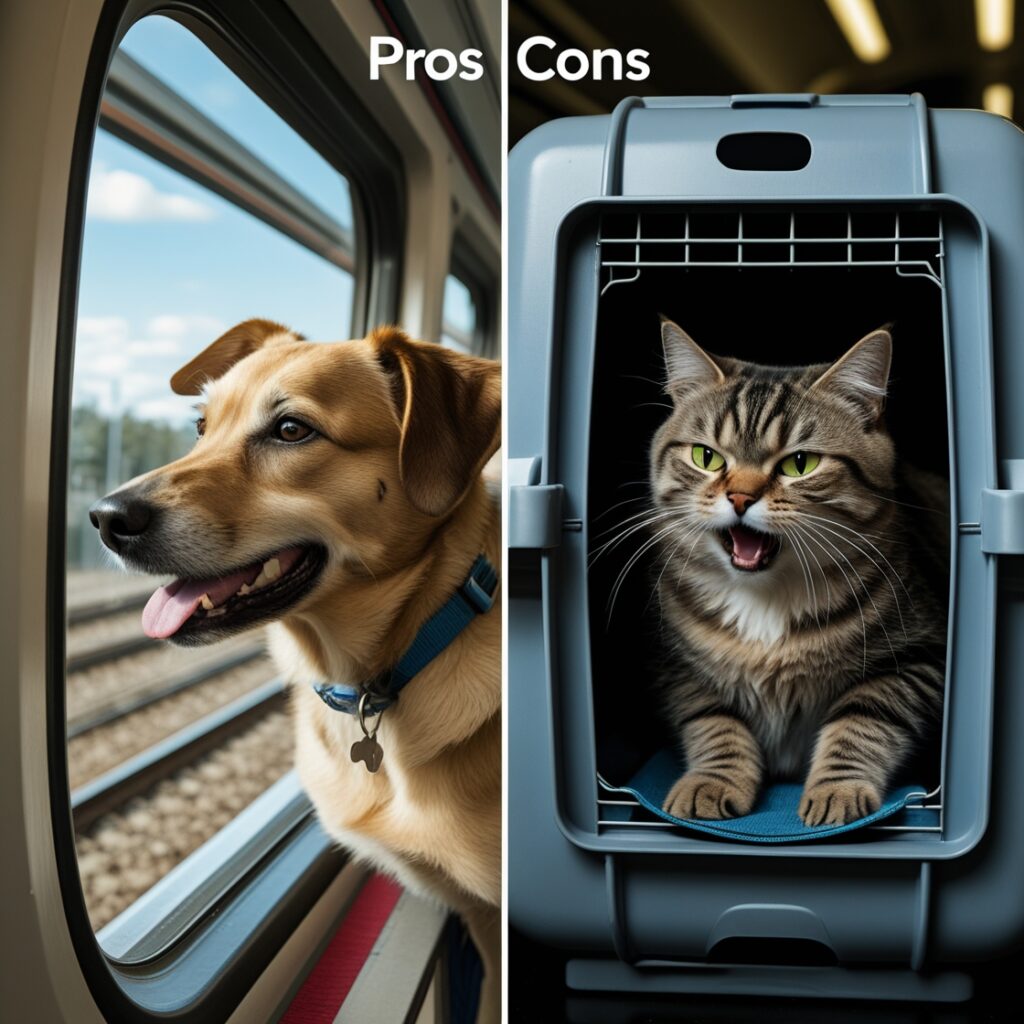🐾 All Aboard the Pet Express! 🚂
Have you ever dreamed of embarking on a scenic train journey with your furry best friend by your side? It sounds like the ideal adventure to have your faithful pet curled up next to you while you watch the world pass by from a train window. But is train travel with pets really as idyllic as it seems?
While the prospect of bringing your pet along for the ride is undoubtedly exciting, it also comes with its own set of challenges and considerations. From navigating train policies to ensuring your pet’s comfort during the journey, there’s a lot to think about. In this blog post, we’ll explore the pros and cons of train travel with pets, helping you decide if it’s the right choice for you and your furry friend. We’ll cover everything from the benefits of choosing trains over other modes of transportation to the potential hurdles you might face along the way. As we set out on our educational excursion into the world of rail travel with our animal companions, grab a treat for your pet and settle in.

Benefits of Train Travel with Pets
Comfort and space for your furry friend
Compared to cars or airplanes, trains offer more space for pets. To ensure the comfort of both you and your pet, several trains offer special pet rooms or permit pets in ordinary seating.
Avoiding car stress and motion sickness
Train journeys can be less stressful for pets prone to motion sickness. The smoother ride and ability to move around can help reduce anxiety and nausea often associated with car travel.
| Train Travel Benefits | Car Travel Drawbacks |
|---|---|
| Smoother ride | Frequent stops |
| More space to move | Confined space |
| Less motion sickness | Higher stress levels |
Preparing Your Pet for Train Travel
Essential documentation and health certificates
- Required documents:
- Pet passport
- Vaccination records
- Health certificate
Training your pet for public spaces
Expose your pet to a variety of surroundings to get them ready for train travel. Practice basic commands to ensure good behavior during the journey. Increase the exposure duration gradually to replicate lengthier journeys.
| Training Focus | Importance | Tips |
|---|---|---|
| Socialization | High | Expose to different people and sounds |
| Obedience | Critical | Practice ‘sit’, ‘stay’, and ‘quiet’ commands |
| Crate training | Essential | Make the carrier a comfortable space |
Train Policies and Regulations for Pets
Size and breed restrictions
- Most trains allow small pets (under 20 lbs)
- Larger breeds often restricted or prohibited
- Some breeds may be banned due to safety concerns
| Pet Type | Typically Allowed | Often Restricted |
|---|---|---|
| Small dogs | ✓ | |
| Cats | ✓ | |
| Large dogs | ✓ | |
| Exotic pets | ✓ |
Ticket requirements and additional fees
Train companies usually charge extra for pets. Fees vary but can range from $20 to $50 per pet. Some require separate tickets for animals, while others include them in the owner’s fare. Always check specific policies when booking to avoid surprises at the station.

Potential Challenges of Train Travel with Pets
A. Limited bathroom breaks for your pet
- Challenges:
- Infrequent stops
- Small train bathrooms
- Motion sickness
B. Dealing with anxious or stressed animals
Traveling by train can be stressful for pets unaccustomed to the experience. Anxiety may be brought on by the restricted areas, strange noises, and continuous movement. Utilize alleviating helps such as pheromone splashes or anti-anxiety drugs that your veterinarian has prescribed to assist reduce this. Additionally, bringing familiar items such as toys or blankets can provide comfort during the journey.
Alternatives to Train Travel with Pets
A. Driving: pros and cons
- Pros:
- Flexibility in schedule
- No pet restrictions
- Frequent stops for pet breaks
- Cons:
- Longer travel time
- Potential stress for pets
- Limited space in car
B. Flying: requirements and considerations
Flying offers a quicker alternative but comes with its own set of challenges. Airlines have specific pet policies, often requiring health certificates and approved carriers. While it’s faster, the experience can be stressful for pets due to unfamiliar environments and potential pressure changes.
Train travel with pets can be a rewarding experience, offering unique benefits such as reduced stress, cost-effectiveness, and the opportunity to enjoy scenic routes together. It necessitates thorough planning, though, which includes acclimating your pet to the train environment and making sure that all rules and regulations are followed. Indeed on the off chance that there are deterrents like space imperatives and conceivable unsettling influences to other travelers, these issues can be reduced with cautious arranging.

Ultimately, whether train travel with pets is worth it depends on your individual circumstances and your pet’s temperament. For individuals looking for a more laid-back and eco-friendly mode of transportation, trains can be a great option. However, other modes of transportation might be more appropriate if your pet is easily agitated or if you’re going on a lengthy trip. When making this choice, take into account both your personal travel preferences and your pet’s requirements and comfort.



